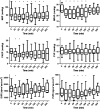Sildenafil attenuates pulmonary arterial pressure but does not improve oxygenation during ARDS
- PMID: 20130830
- PMCID: PMC2850529
- DOI: 10.1007/s00134-010-1754-3
Sildenafil attenuates pulmonary arterial pressure but does not improve oxygenation during ARDS
Abstract
Objective: Pulmonary hypertension is a characteristic feature of acute respiratory distress syndrome (ARDS) and contributes to mortality. Administration of sildenafil in ambulatory patients with pulmonary hypertension improves oxygenation and ameliorates pulmonary hypertension. Our aim was to determine whether sildenafil is beneficial for patients with ARDS.
Design: Prospective, open-label, multicenter, interventional cohort study.
Setting: Medical-surgical ICU of two university hospitals.
Patients: Ten consecutive patients meeting the NAECC criteria for ARDS.
Interventions: A single dose of 50 mg sildenafil citrate administered via a nasogastric tube.
Main results: Administration of sildenafil in patients with ARDS decreased mean pulmonary arterial pressure from 25 to 22 mmHg (P = 0.022) and pulmonary artery occlusion pressure from 16 to 13 mmHg (P = 0.049). Systemic mean arterial pressures were markedly decreased from 81 to 75 mmHg (P = 0.005). Sildenafil did not improve pulmonary arterial oxygen tension, but resulted in a further increase in the shunt fraction.
Conclusion: Although sildenafil reduced pulmonary arterial pressures during ARDS, the increased shunt fraction and decreased arterial oxygenation render it unsuitable for the treatment of patients with ARDS.
Figures


Comment in
-
Sildenafil for pulmonary hypertension in ARDS: a new pleasant effect?Intensive Care Med. 2010 May;36(5):729-31. doi: 10.1007/s00134-010-1771-2. Epub 2010 Feb 4. Intensive Care Med. 2010. PMID: 20130829 No abstract available.
-
Should we administer sildenafil to patients with acute respiratory distress syndrome? No.Intensive Care Med. 2010 Jun;36(6):1102-3; author reply 1104-5. doi: 10.1007/s00134-010-1865-x. Epub 2010 Mar 24. Intensive Care Med. 2010. PMID: 20333352 No abstract available.
Similar articles
-
Combination therapy with oral sildenafil and inhaled iloprost for severe pulmonary hypertension.Ann Intern Med. 2002 Apr 2;136(7):515-22. doi: 10.7326/0003-4819-136-7-200204020-00008. Ann Intern Med. 2002. PMID: 11926786 Clinical Trial.
-
Sildenafil for pulmonary hypertension in ARDS: a new pleasant effect?Intensive Care Med. 2010 May;36(5):729-31. doi: 10.1007/s00134-010-1771-2. Epub 2010 Feb 4. Intensive Care Med. 2010. PMID: 20130829 No abstract available.
-
Sildenafil increased exercise capacity during hypoxia at low altitudes and at Mount Everest base camp: a randomized, double-blind, placebo-controlled crossover trial.Ann Intern Med. 2004 Aug 3;141(3):169-77. doi: 10.7326/0003-4819-141-3-200408030-00005. Ann Intern Med. 2004. PMID: 15289213 Clinical Trial.
-
Sildenafil in the treatment of pulmonary hypertension.Vasc Health Risk Manag. 2006;2(4):411-22. doi: 10.2147/vhrm.2006.2.4.411. Vasc Health Risk Manag. 2006. PMID: 17323595 Free PMC article. Review.
-
Sildenafil citrate for the treatment of pulmonary hypertension.Drugs Today (Barc). 2006 Dec;42(12):771-84. doi: 10.1358/dot.2006.42.12.1032057. Drugs Today (Barc). 2006. PMID: 17285150 Review.
Cited by
-
Pulmonary artery targeted therapy in treatment of COVID-19 related ARDS. Literature review.Biomed Pharmacother. 2022 Feb;146:112592. doi: 10.1016/j.biopha.2021.112592. Epub 2021 Dec 25. Biomed Pharmacother. 2022. PMID: 35062063 Free PMC article. Review.
-
Phosphodiesterase Inhibitors in Acute Lung Injury: What Are the Perspectives?Int J Mol Sci. 2021 Feb 16;22(4):1929. doi: 10.3390/ijms22041929. Int J Mol Sci. 2021. PMID: 33669167 Free PMC article. Review.
-
Acute right heart decompensation in a multiple trauma patient with chronic pulmonary hypertension.Intensive Care Med. 2011 Apr;37(4):723-4. doi: 10.1007/s00134-010-2122-z. Epub 2011 Jan 14. Intensive Care Med. 2011. PMID: 21234745 No abstract available.
-
Inhaled Nitric Oxide in Acute Respiratory Distress Syndrome Subsets: Rationale and Clinical Applications.J Aerosol Med Pulm Drug Deliv. 2023 Jun;36(3):112-126. doi: 10.1089/jamp.2022.0058. Epub 2023 Apr 20. J Aerosol Med Pulm Drug Deliv. 2023. PMID: 37083488 Free PMC article. Review.
-
Role of Sildenafil in Management of Pediatric Acute Respiratory Distress Syndrome.J Pediatr Intensive Care. 2021 Jun 19;12(2):148-153. doi: 10.1055/s-0041-1730900. eCollection 2023 Jun. J Pediatr Intensive Care. 2021. PMID: 37082473 Free PMC article.
References
-
- Schultz MJ, Haitsma JJ, Zhang H, Slutsky AS. Pulmonary coagulopathy as a new target in therapeutic studies of acute lung injury or pneumonia—a review. Crit Care Med. 2006;34:871–877. - PubMed
Publication types
MeSH terms
Substances
LinkOut - more resources
Full Text Sources
Medical

